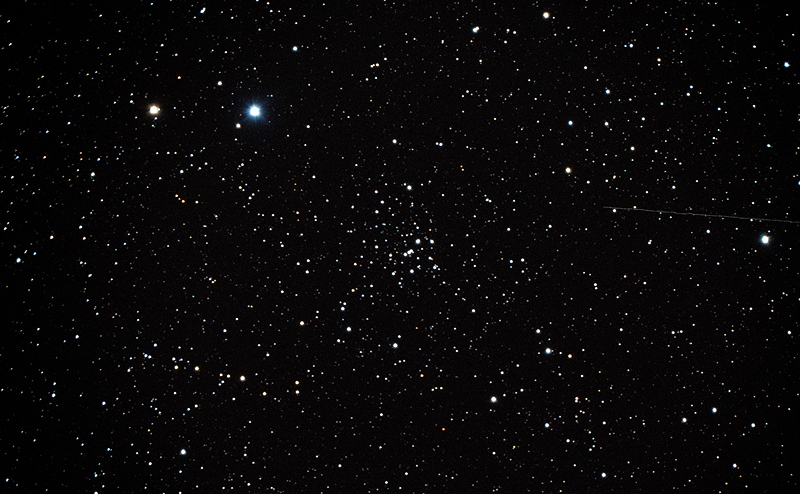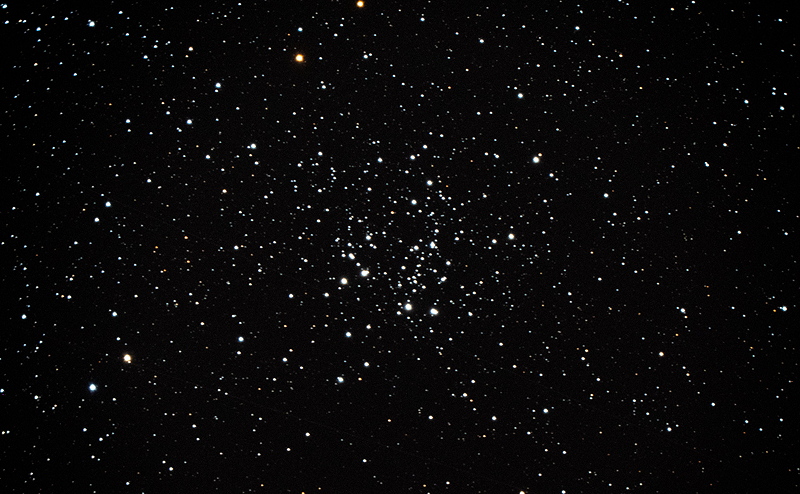Cassiopeia rising over Cassiopeia Observatory;
Cassiopeia Open Clusters
Posted: 8 September 2018
Cloudy skies returned on Friday, 31 August 2018, as a Monsoon system approached. Saturday, 1 September, I attended a Live Music and Star Party event at our local Oracle State Park, an IDA "International Dark Sky Park", which turned out surprisingly well. I have posted a report on the Oracle Dark Skies Committee web site.
After midnight Sunday, 2 September, there was a strong Monsoon thunderstorm with lightning and heavy rain (0.55"). About an hour before sunset on Sunday a brief thundershower came through (0.06" rain). And about an hour before sunset on Monday, 3 September, a strong brief thunderstorm occurred with lightning, rain (0.24"), and a full rainbow as the storm ended:

About noon on Tuesday, 4 September, there was another brief thunderstorm with lots of lightning, thunder, and rain (0.13"). Cloudy skies continued until Thursday, 6 September, which dawned clear. However, clouds began returning mid-day.
Late Thursday afternoon I attended the quarterly meeting of the Oracle Dark Skies Committee. At the meeting I announced that I would be retiring from the Chair position at the December 2018 meeting. I have been the Chair since the Committee was formed in April 2014 to pursue the successful nomination of Oracle State Park as an IDA "International Dark Sky Park", making it the first park in the Arizona State Parks system to receive this prestigious designation.
Friday, 7 September, dawned clear but some clouds appeared mid-day. With the sky clearing as sunset approached I decided to open the observatory.
|
Open: Friday, 7 September 2018, 1829 MST Temperature: 77°F |
Session: 1272 Conditions: Mostly clear |
Equipment Used:
12" f/8 LX600 w/StarLock
2" 24mm UWA eyepiece
Focal Reducer
Camera:
D850 DSLR
SYNCed observatory clock to WWV.
1839 MST: LX600 ON, StarLock OFF, High Precision OFF.
1842 MST: sunset.
Viewed Venus, 102X. It was now showing a "fat" crescent phase. Unfortunately, it is getting lower in the southwestern sky after sunset and so more affected by poor seeing after dark.
Viewed Jupiter, 102X. The four Galilean Moons and the Great Red Spot were visible.
Then took a quick look at Saturn, 102X.
Next was Mars, 102X. The South Polar Cap was visible as a bright white spot. A large dark surface area was faintly visible.
I then began preparing the D850 DSLR for sky astrophotography as I waited for the sky to get darker.
1930 MST: the Milky Way was becoming visible. Humidity was somewhat high. It was definitely muggy this night. My logbook paper was damp.
1945 MST: began photographing the constellation of Cassiopeia rising over Cassiopeia Observatory. The D850 DSLR was mounted on a camera tripod and placed outside of the observatory. This is an f/16, 30 seconds, ISO 3200, FL 24mm, photo:

Mouseover or tap on image to see the "W" shape
2005 MST: returned to the observatory and began preparing to image some Open Star Clusters in Cassiopeia for my updated Cassiopeia Constellation Astrophotography Album. Mounted the D850 at prime focus + focal reducer, focused on the star Shedir in Cassiopeia, and locked the 12" mirror using the ScopeStuff mirror lock to prevent focus shifts. 2013 MST: High Precision ON, StarLock ON.
Took these (slightly cropped) images, 2 minutes, ISO 3200, White Balance 5000K:
NGC654

NGC659

NGC663

NGC743

M52

Due to the faint satellite appearing in the image of NGC659, I will re-image it on the next session.
2035 MST: began seeing some lightning flashes in the northeastern sky. No storm clouds were visible.
2103 MST: Wi-Fi ON. Used SkySafari 6 Pro to GOTO to a faint asteroid that I wanted to image. I had planned to image two faint asteroids this session but seeing was so bad in the southern sky that good StarLock autoguiding was impossible. 2137 MST: I gave up trying to image due to the poor seeing. Will hopefully image these two faint asteroids on the next session. I had been planning to image these asteroids when they were both brighter, but travel, the Moon, and cloudy nights all conspired against my plans.
2150 MST: after removing the camera from the 12" telescope I viewed Mars and Saturn, 102X. Five moons were now visible at Saturn.
Next, viewed M8 (Lagoon Nebula), M16 (Eagle Nebula), M17 (Swan Nebula), and M20 (Trifid Nebula), 102X. All were nice views.
2157 MST: LX600 OFF.
As I was leaving the observatory I saw this praying mantis on bay floor:

|
Close: Friday, 7 September 2018, 2211 MST Temperature: 75°F |
Session Length: 3h 42m Conditions: Clear |
Comments are welcome using Email. Twitter users can use the button below to tweet this report to their followers. Thanks.
Cassiopeia Observatory Home Page
Copyright ©2018 Michael L. Weasner / mweasner@me.com
URL = http://www.weasner.com/co/Reports/2018/09/08/index.html
